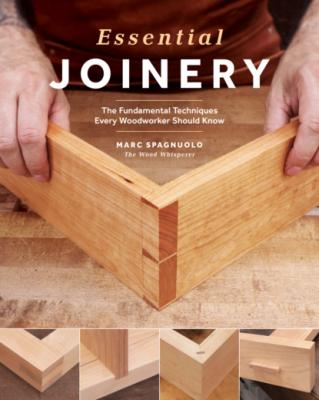ТОП просматриваемых книг сайта:
Essential Joinery. Marc Spagnuolo
Читать онлайн.Название Essential Joinery
Год выпуска 0
isbn 9781951217167
Автор произведения Marc Spagnuolo
Жанр Сделай Сам
Издательство Ingram
25
ESSENTIAL JOINERY
Butt Joints | CORNER CASE BUTT JOINT USING BISCUITS
4. The adjoining panel receives
slots on the face of the panel. Use
a piece of scrap on the back side
to help keep the biscuit joiner
square and balanced.
5. Insert biscuits into the slots.
I prefer #20 biscuits for most
casework.
6. Assemble the joint. When
being careful about which face of
the board we use for reference,
it’s very easy to get a perfectly
flush fit.
5
6
4
26
ESSENTIAL JOINERY
CORNER CASE BUTT JOINT USING DOMINOES
While the Domino cuts what is technically a loose mortise and tenon joint, for
casework, the Dominoes function in the same way a biscuit does.
1. Arrange the parts to be
joined and mark the center point
of each Domino in the same
fashion as when using the biscuit
joiner (page 24). Plunge mortises at each pencil location on both workpieces.
2. Plunge mortises into the
adjoining pieces using a piece
of scrap behind the work for
additional support.
3. Assemble the joint.
4. Check for square and make
sure the outside surface is flush.
1
2
3
4
TOOLS
Domino joiner
Adjustable square
27
ESSENTIAL JOINERY
FLAT 45° MITERS: A FRAME
A flat miter joint is a butt joint where each piece is mitered at an angle (usually 45°).
The most common and recognizable application for this is the classic picture frame.
You’ll also see flat miter joints in doors and other applications where a decorative
frame is required.
45° MITERS on TABLESAW Using MITER GAUGE
TOOLS
Square
Tablesaw
Miter gauge
1. Use a large accurate square
to calibrate the miter gauge,
making sure it is perfectly
perpendicular to the blade.
2. Set the miter gauge to 45°.
Most quality miter gauges will be
accurate at 45° as long as they
are calibrated correctly at 90°,
but we’ll double-check using test
pieces. Don’t forget to slide the
miter gauge as needed to keep it
out of the path of the blade.
3. Using a stop block on the
miter gauge, make a test cut on
two jointed and planed pieces
of scrap.
1
2
3
28
ESSENTIAL JOINERY
FLAT 45° MITERS: A FRAME | Butt Joints
4. Place the 45° miters together
to form a 90° corner and check for
square. If the miter gauge is off,
this measuring method makes it
easy to see because your error is
essentially doubled.
5. Set the gauge slightly to
the side of the 45° notch and test
cut again.
6. Now the two 45° cuts result
in a perfect 90° corner.
7. Cut the actual workpieces
using stop on the miter gauge.
8. Save those little triangle
offcuts for clamping help later.
9. The miters should be nice and
even when held side by side.
4
5
6
7
8
9
29
ESSENTIAL JOINERY
Butt Joints | FLAT 45° MITERS: A FRAME
45° FLAT MITERS with MITER SAW
TOOLS
Miter saw
Square
Clamp
1. Use a reliable square to make
sure the miter saw fence is
square to the blade.
2. Adjust the saw to 45° and
use two jointed and planed pieces
of scrap to make two test cuts.
3. Put the 45° miters together
and check for square. As you can
see, there is quite a bit of error to
adjust for.
1
2
3
TIP
When making precise cuts
at the miter saw, it’s a good
idea to use a clamp. The workpiece
won’t move and you won’t need to
use as much hand pressure to hold
the piece in place.
30

